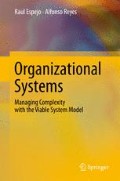Abstract
Organizational systems are the main object of observation and study in this book. This is the first chapter of four that build up the Viplan Method to study organizational systems. This method is a heuristic, useful in taking decisions to improve an organization’s effectiveness. VIPLAN stands for viability planning. It starts by addressing questions such as: What does the organization do? Who are its stakeholders? How can we differentiate this organization from others? These questions point to the discussion of the organization’s identity as an issue regarding its description. In this chapter we focus on these questions using a tool called naming systems. We explain the use of naming systems as a suitable methodological tool to guide identity workshops in this regard. We also introduce the notion of the enabling viewpoint as the viewpoint using the Viplan Method to facilitate the modelling of this organization. A concrete output of this initial step of the method is a set of appropriate names describing the organization in focus in terms of a value added transformation process involving a set of relevant participants. Each of these names can then be used as an input for the next two steps of the method; technological and structural modelling and the unfolding of complexity.
Access this chapter
Tax calculation will be finalised at checkout
Purchases are for personal use only
Notes
- 1.
Drawn by Jack Botwinick under the title of ‘My husband and my father-in-law’ http://www.google.com/images?hl=en&rlz=1G1GGLQ_ENUK317&q=Jack+Botwinick&um=1&ie=UTF-8&source=univ&ei=jLLaTPnoDZO7hAe_iLnPAg&sa=X&oi=image_result_group&ct=title&resnum=1&ved=0CCkQsAQwAA
- 2.
Purpose-in-use as opposed to espoused purpose is a distinction mentioned in a previous chapter following Argyris and Schon (1978).
- 3.
Activities are production activities if they produce the organization’s purposes. Production activities are structured as primary activities when they are hypothesised as autonomous units and therefore produce the organization’s unfolding of complexity. Activities are clustered as regulatory functions when their purpose is regulating, supporting or servicing production activities.
- 4.
Shell UK’s abandoning of the deep sea disposal of a storage and loading buoy in the North Atlantic as a result of continuous pressures from Greenpeace during the 1990s see http://pa.oxfordjournals.org/cgi/pdf_extract/51/3/397
- 5.
For instance aspects like Customer Relationship Management have grown in significance, see Best Practice Adoption by Forrester Research 2008 http://www.forrester.com/rb/Research/crm_best_practices_adoption/q/id/44179/t/2
- 6.
The development of data warehousing and data mining techniques to learn about client’s buying habits and expectations is a good example of the importance that organizations are currently giving to this relation (the Amazon retail website is a prime example); also the establishment of schemes such as the mileage programs on airlines and customer cards with bonus points in retailers, is another example of this trend.
- 7.
In Chap. 11 we offer a methodologically focused discussion of naming systems and their role in dealing with problematic situations. Here the focus is on identity statements.
- 8.
TASCOI is a tool related to naming meaningful chunks of complexity in the world, on the other hand Checkland's (1981) CATWOE is a tool related to naming ideas that might be relevant in the world (ideas to think about the world). In TASCOI the T stands for inputs that are transformed into outputs via a technological transformation process (e.g., raw materials into finished products), in CATWOE the T often stands for changes of actors’ appreciations (e.g., persons without appreciation about a situation to persons with an appreciation of this situation). CATWOE is coherent with a view that systems are mental constructs of possibilities in the informational domain; on the other hand TASCOI is coherent with the view that communications produce or might produce performative systems in the world, in the operational domain.
- 9.
Perhaps it is useful to remember here our distinction between systems and holons that we made in Chap. 1. While a system is a distinction that brings forth a set of parts non-linearly related exhibiting closure, a holon is a mental construct, an idea or a hypothesis of a whole triggered by observations in the world, regardless of whether it has as a referent a closed network of interacting people.
- 10.
These examples are taken from the Viplan software (Espejo and Bowling 1996).
References
Argyris C, Schon D (1978) Organizational learning: a theory of action perspective. Addison-Wesley, Reading, MA
Beer S (1979) The heart of enterprise. Wiley, Chichester
Bowling D, Espejo R (1993) An intervention with the cybernetic methodology in regent engineering. In: Espejo R, Schwaninger M (eds) Organizational fitness: corporate effectiveness through management cybernetics. Campus Verlag, Frankfurt and New York, pp 299–330
Checkland P (1981) Systems thinking, systems practice. Wiley, Chichester
Cortina A (1996) Etica de la empresa. Trotta, Madrid
Espejo R (1994) What’s systemic thinking? Syst Dynam Rev 10(2–3 Summer–Fall):199–212
Espejo R, Bowling D (1996) Viplan learning system: A method to learn the viable system model. Syncho, Ltd., Birmingham, www.syncho.com
Espejo R, Schuhmann W, Schwaninger M, Bilello U (1996) Organizational transformation and learning. Wiley, Chichester
Organ DW, Podsakoff PM, MacKenzie SB (2006) Organizational citizenship behavior: its nature, antecedents, and consequences. Sage, London
Ulrich W (2000) Reflective practice in the civil society: the construction of critically systemic thinking. Reflective Pract 1(2):247–268
Waddell S (2000) New institutions for the practice of corporate citizenship: historical intersectoral, and developmental perspectives. Bus Soc Rev 105:323–345
Wilson B (1984) Systems: concepts, methodologies and applications. Wiley, Chichester
Womack JP, Jones D (2003) Lean thinking: banish waste and create wealth in your corporation (revised and updated). Harper Business, London
Author information
Authors and Affiliations
Corresponding author
Rights and permissions
Copyright information
© 2011 Springer-Verlag Berlin Heidelberg
About this chapter
Cite this chapter
Espejo, R., Reyes, A. (2011). Naming Systems: Tool to Study Organizational Identity. In: Organizational Systems. Springer, Berlin, Heidelberg. https://doi.org/10.1007/978-3-642-19109-1_7
Download citation
DOI: https://doi.org/10.1007/978-3-642-19109-1_7
Published:
Publisher Name: Springer, Berlin, Heidelberg
Print ISBN: 978-3-642-19108-4
Online ISBN: 978-3-642-19109-1
eBook Packages: Business and EconomicsBusiness and Management (R0)

